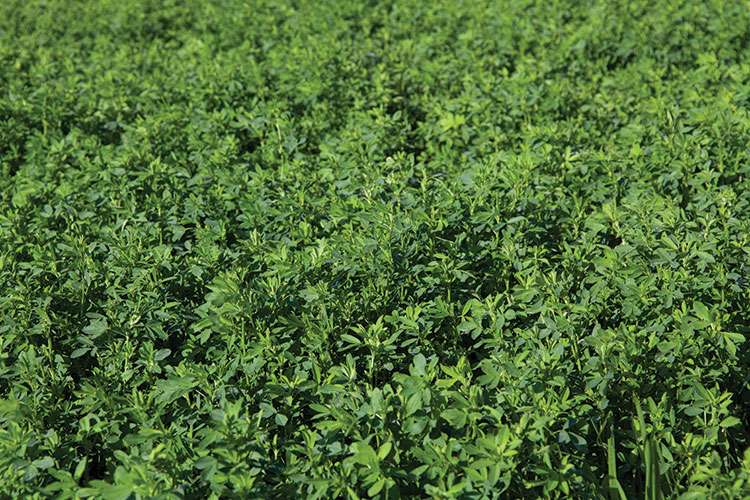Get your soybean meal from alfalfa fields |
| By John Goeser |
|
|
The author is the director of nutrition research and innovation with Rock River Lab Inc, and adjunct assistant professor, University of Wisconsin-Madison’s Dairy Science Department.  With skyrocketing protein costs following a challenged growing season in South America, forage protein value is under the microscope. Improved U.S. soybean complex exports have contributed to driving up soybean prices, and all other protein-rich feeds have followed suit. Protein feeds have risen by $100 per ton or more relative to prior years, which have tightened margins. Growing higher quality feed is one avenue to ease the rising feed cost burden. Agronomists are taking note as well, with one group recently posing the question, “What should we focus on during high protein and energy feed cost times?” To their credit, leading agronomists for dairies are teaming up with farmers and their nutritionists to improve forage quality. Higher forage quality can lessen the feed cost per hundredweight in multiple ways. The paths to widening feed margins are as follows:
A push for more protein Getting to any of these three outcomes can be a bit complicated, but our focus in this article will be the second point. Specific to alfalfa or grass, improved protein yield can have substantial economic impact. This year, with soybean meal prices nearing $450 per ton, we have added incentive to push for greater protein content in our harvested hay or haylage crops. The economic return from small improvements in alfalfa protein content can quickly add to ration cost savings. Consider the following math, using a 5-ton dry matter yield for alfalfa hay or haylage as an example:
As can be seen, a seemingly small one percentage unit bump in crude protein yield for alfalfa can translate into 220 pounds more soybean meal equivalent per acre. This added soybean meal equivalent per acre carries about a $50 per acre value! Keep the leaves According to Dan Undersander, emeritus forage agronomist with the University of Wisconsin, the harvested leaf percentage of alfalfa accounts for 70% of the forage’s relative forage quality (RFQ). He further states that it’s even more important than maturity at harvest. Alfalfa leaves contain about 25% to 30% crude protein while the stems have only 6% to 10%. Recently, I brought this protein issue up with a group of skilled and experienced agronomists. In that discussion, we began with the understanding that the leaf-to-stem ratio drives protein content in alfalfa. The leaves are rich in both protein and energy, while the stem carries the fiber to keep the plant standing. There’s been some discussion about developing leaf-to-stem laboratory measures in the past, but a protein and fiber analysis essentially tells us what we need to know. There are then several ways to go about enhancing forage protein content by way of harvesting more leaves. From a management standpoint, cutting alfalfa sooner will yield more leaves and fewer stems. I always recommend monitoring the stand’s maturity rather than relying on calendar dates. A 28-day cutting interval can yield anything from dairy-quality alfalfa to a bedding worthy crop. Also, take care when handling the crop during merging or raking, as any added handling will drop more leaves in the field, especially if the crop is relatively dry. Prior to harvest, there are other options that will help yield more leaves. Ideally, we want to lean on published research as well as practical experience to outline the key paths to greater leaf retention. Added crop protection and ensuring adequate soil fertility are options we should evaluate this year. Insect damage impacts crop quality, so applying insecticides is generally a routine practice for many growers. During conversations with Damon Smith, an extension plant pathologist with the University of Wisconsin, I’ve learned that foliar fungicide applications to alfalfa can improve forage quality when cutting intervals exceed 35 days. In collaborative meetings with crop advisers and agronomists, I’ve also learned that supplemental fertility applications can also help in some situations. Ensuring adequate nitrogen is available to forage grasses will have a profound impact on crude protein concentration. Consult with your crop adviser to take these discussions further for your farm. Take steps to preserve the leaf-to-stem ratio to improve hay or haylage protein content. There could be $50 per acre or more of gross revenue in soybean meal equivalent out in your alfalfa fields with proven adjustments to your agronomic plan. This article appeared in the April/May 2021 issue of Hay & Forage Grower on page 12. Not a subscriber? Click to get the print magazine. |
